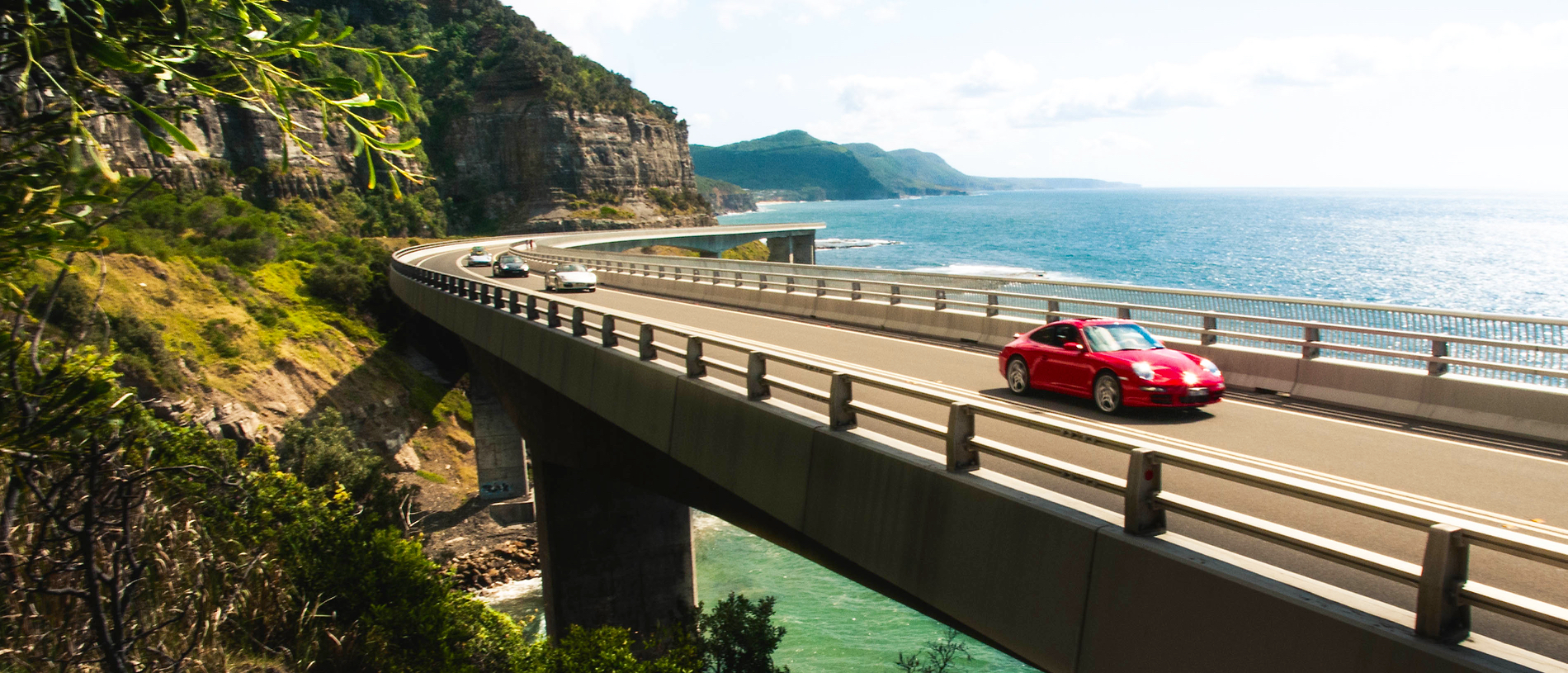
Hitting the road in New South Wales
I’ve never been much of a petrol head. Cars, for me, were little more than a convenient mode of transport. Until now.
Gav, leans in through the window, “I want you to try something before we set off,” he says. “Put your foot down. Like, right down, for a moment.” I oblige, and with a roaring throaty gargle, the Porsche 911 Carrera (red, of course) comes alive. I grin. “Thought you’d like that,” he chuckles.
Cruising south along the Grand Pacific Drive from Sydney in a car that feels built specifically for this stretch of road is exhilarating. The quick gear shifts to match the curvaceous coastal highway; the way it feels velcroed to the tarmac; and that voice! Sadly, this is not my car. The Porsche belongs to Gavin’s company, Cliff to Coast Sports Cars, and he’s allowing me the all-too-brief pleasure of an afternoon drive.
The famous Seacliff Bridge unfurls in front of us. Smooth concrete pillars rise from the sea to support the road curving around the cliffs, with crashing surf below. The Porsche purrs appreciatively.
It’s just a shame that my sister is growing increasingly pale and quiet beside me. When we arrive in Wollongong she is green with car sickness and as grateful to get out of the 911 as I am reluctant.
We get our bearings in Wollongong, meandering along the seafront, breezy and balmy in the early evening. Down at the harbour basin, we eat sashimi so fresh it may have been caught with a line cast from our table. Outside, hordes of seagulls and the occasional pelican dive for their own dinner and rowing crews, wearing nothing but slivers of lycra and bushy beards, carve through the choppy waves.
The sea is calmer the next morning and our beachfront breakfast spot is filled with glossy, tanned customers: shirtless surfers and women in fluorescent bikinis.
For contrast, we head to the huge Nan Tien Buddhist temple. Set amidst immaculate, fragrant grounds, the temple is bright, cheerful and tranquil. We eat at the Dew Drop Inn Tea House where, by Buddhist decree, the food is free from meat, fish, onions and garlic. The sticky vegan dumplings are delicious.
Further south at the Illawarra Fly Tree Top Walk we are grateful for the shade of the bush in the thick afternoon heat. We climb the high metal walkway to the top of the tower, 50m above the trees. The view stretching hazily north is magnificent, though with fizzy legs and sweaty palms, I’m not really in a fit state to appreciate it. My braver sister ventures to the end of the cantilevered walkway, bouncing nauseatingly above the treetops.
Bowral, in the Southern Highlands, is a monied town with verdant, manicured gardens that belie the extremes of the weather here. By 10am, the sun is already ferociously hot in a cloudless sky, and when we stop for coffee in Bong Bong Street, the digital thermometer above the bank reads 31ºc.
As we drive north, the sky gets bigger, the grass browner. This is the rural Australia of paintings: scorched, rugged, beautiful.
Our rental car’s chilly air conditioning begins to feel inappropriate, and we pull over – opening the doors to a billowing cloud of dry heat and waft of eucalyptus. Apart from the screech of passing cockatoos, there is nothing but the soft susurrus of the long grass.
The scenery in the Blue Mountains is greener, steeper and even more dramatic than the big, bucolic fields. Outside the small town of Oberon we drive into a capital ‘V’ of a valley, down a road so vertiginous we feel like the soaring hills might close over the top of us and we’ll be swallowed into limestone landscape.
Beneath us, the Jenolan Caves are as deep as the valley is high. It’s an immense network of slick, cool tunnels, underground rivers and glittering mineral deposits. We snake along dimly lit passageways, bent almost double. Deeper underground, down a narrow staircase, the lights glow green, and Scott, our guide, gets us to watch as he tosses a pebble off the path. The green light plops and ripples in front of us: it is the river, so still and clear it’s invisible.
The vastness of everywhere we go is difficult to really comprehend.
At Scenic World, a theme park access point to the wilderness, the Blue Mountains stretch from our rocky vantage for hundreds of kilometres. We catch a glass-floored cable car across the valley, watching specks of people standing on the edge of the cliffs below us.
Then we ride the world’s steepest funicular railway down into the trees, which at 52º, feels near enough to vertical. Around us, the landscape is extravagant, almost cartoonish: orange wedges of cliff frosted in dense greenery and decorated with the white twinkle of cockatoos.
The mountains grow bluer as they fade to the horizon. And when we leave they seem to tag along, postcard-size in the rear-view mirror and as fluttering glimpses between buildings along the highway, back to the hot bustle of Sydney.
